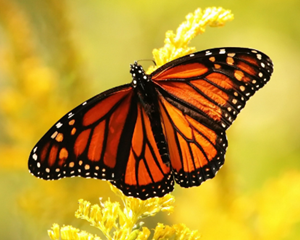Some animals don't want to run the risk of getting infected by disease-carrying and itchy ticks and mosquitoes, so they use their own form of insect repellent.
有些動物不想冒被攜帶疾病、發癢的蜱蟲和蚊子感染的風險,因此它們使用自己的驅蟲劑。
Various species of capuchin monkeys from South America and some species of lemurs from Madagascar have been observed hunting the slinky millipede Orthoporus dorsovittatus, biting and crushing the worm in their hands, and then coating their fur with the oozing goo from its insides.
人們觀察到,來自南美的各種卷尾猴和來自馬達加斯加的一些狐猴,會捕獵柔軟的千足蟲Orthoporus dorsovittatus,它們會用手咬住并壓碎這種蠕蟲,然后用蠕蟲內部滲出的粘液涂在它們的皮毛上。
They did this more during seasons when mosquitoes and other biting insects were more abundant.
在蚊子和其他叮咬昆蟲更豐富的季節,他們會更頻繁地這樣做。
And in 2003, scientists discovered that these millipedes secrete toxic chemicals called benzoquinones which actively repel mosquitoes.
2003年,科學家發現這些千足蟲會分泌一種叫做苯醌的有毒化學物質,可以有效驅除蚊子。
"Does this mean they know what they are doing? Not necessarily. They could just be doing do it because it feels good," says Emory University evolutionary biologist Jacobus De Roode. "But we do know the behavior helps against bites and infections."
“這是否意味著它們知道自己在做什么?未必。它們可能只是因為感覺良好而這樣做,”埃默里大學進化生物學家雅各布斯·德魯德說。“但我們確實知道這種行為有助于防止叮咬和感染。”
In a 2022 study on chimpanzees in Gabon, scientists observed a total of 76 different times chimps accidentally wounded themselves.
在2022年對加蓬的黑猩猩進行的一項研究中,科學家觀察到黑猩猩總共有76次不同時間意外受傷。
In 19 of those cases, the chimps tended to their wound in an unusual way -- with squished insects.
在其中19個案例中,黑猩猩以一種不尋常的方式處理傷口--用壓碎的昆蟲。
A chimp called Freddy, who had a day-old wound on his left arm, was spotted snatching a leaf and using his mouth to pluck off an unidentified insect, then pressing it softly against the gash.
一只名叫弗雷迪的黑猩猩的左臂上有一個傷口已經一天了,有人發現它抓起一片葉子,用嘴叼掉一只身份不明的昆蟲,然后輕輕地將它壓在傷口上。
Chimps did this for each other as well: one chimpanzee female caught an insect and handed it over to another unrelated chimpanzee male, who then applied it to the open wound of another unrelated male.
黑猩猩之間也這樣做:一只雌性黑猩猩抓住一只昆蟲,并將其交給另一只無關的雄性黑猩猩,然后雄性黑猩猩將其涂在另一只無關的雄性的開放性傷口上。

These behaviors weren't "just a coincidence," says Simone Pika, a comparative biocognition researcher at the University of Osnabrück, but they don't know whether this behavior indeed helps to increase wound healing.
奧斯納布呂克大學的比較生物認知研究員西蒙娜·皮卡表示,這些行為“不僅僅是巧合”,但它們不知道這種行為是否確實有助于促進傷口愈合。
It may just be a social custom the chimpanzees of that community have learned, she says, but given the "unambiguous context" of the wounds, there's reason to believe this is a medication behavior.
她說,這可能只是該群體的黑猩猩學到的一種社會習俗,但考慮到傷口的“明確背景”,有理由相信這是一種藥物行為。
In Mexico City Universidad Nacional Anutónoma de México behavioral ecologist Constantino de Jesús Macías García's students found that the most common man-made item local birds used to make their nests were cigarettes.
在墨西哥城墨西哥國立阿努托諾馬大學,行為生態學家康斯坦丁諾·德·赫蘇斯·馬西亞斯·加西亞的學生發現,當地鳥類用來筑巢的最常見的人造物品是香煙。
Since nicotine, derived from tobacco, is occasionally used as a parasite repellent for garden pests, his team tested whether birds were lining their homes with shreds of cigarettes for this purpose.
由于從煙草中提取的尼古丁偶爾被用作花園害蟲的寄生蟲驅避劑,因此他的團隊測試了鳥類是否會為此目的在家中鋪上煙絲。
In an experiment with over 50 bird nests of local house finches and house sparrows, the team found that nests with the cellulose from smoked cigarette butts attracted significantly fewer mites, lice, and ticks than their non-smoker counterparts.
在對50多個本地家雀和家麻雀的鳥巢進行的實驗中,研究小組發現,與不吸煙的鳥巢相比,使用來自煙蒂的纖維素的鳥巢所吸引的螨蟲、虱子和蜱蟲要少得多。
They also found that exposure to those cigarette butts damages the red blood cells of both bird chicks and adults, but that the chicks weigh more -- indicating health -- the more cigarette butts are used in the construction of their nests.
他們還發現,接觸這些煙頭會損害雛鳥和成鳥的紅血球,但在筑巢時使用的煙頭越多,雛鳥的體重就越重(顯示健康)。
"Although toxic, the net benefit is positive," says Jesús Macías García, suggesting this is a form of prophylaxis (practice to prevent disease) for urban birds.
“雖然有毒,但凈效益是積極的”,德·赫蘇斯·馬西亞斯·加西亞說,他認為這是城市鳥類的一種預防措施(預防疾病的做法)。
He thinks cigarettes are used in lieu of aromatic plants that these birds would have available in nature.
他認為香煙是用來代替這些鳥類在自然界中可以獲得的芳香植物的。
When monarch butterflies contract the potentially lethal, wing-deforming disease Ophryocystis elektroscirrha, they eat types of milkweed species that contain higher levels of cardenolides which are toxic to the disease's spores inside their body.
當帝王蝶感染了可能致命的、使翅膀變形的疾病Ophryocystis elektroscirrha時,它們會吃含有較高水平的強心烯內酯的馬利筋品種,而強心烯內酯對它們體內的疾病孢子有毒。
In experiments, when given a choice, female monarchs chose to lay eggs on the more toxic milkweed, and the probability that their eggs would be infected dropped.
在實驗中,當有選擇時,雌性帝王蝶選擇在毒性更強的馬利筋上產卵,它們的卵被感染的可能性就會下降。
"These mothers basically make choices based on the future infection of their offspring," says De Roode. "Now, does this mean intentionality? Not necessarily, but it does mean that the cause for their behavior is infection. They may not know they are infected, their bodies may simply prefer the more bitter plants."
“這些母親基本上是根據后代未來感染的情況做出選擇,”德魯德說。“現在,這是否意味著故意為之?不一定,但這確實意味著它們的行為原因是感染。它們可能不知道自己被感染了,它們的身體可能只是更喜歡更苦的植物。”
But given the growing body of research suggesting a wide variation in the examples of medication in the animal world, De Roode's take is that medication in the animal world is much more widespread than previously thought.
但鑒于越來越多的研究顯示動物世界中的藥物治療例子存在很大差異,德魯德認為動物世界中的藥物治療比以前想像的要廣泛得多。
"It's been common from the beginning of time, as soon as there were animals, as soon as there were parasites, there would have been ways for animals to take care of them," says De Roode. "And so the bigger picture is that it's extremely common, yet very much under-explored."
“這從一開始就很常見,只要有動物,只要有寄生蟲,動物就會有辦法照顧它們,”德魯德說。“所以更大的情況是,它非常常見,但尚未得到充分探索。”












